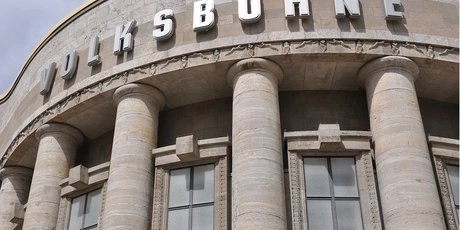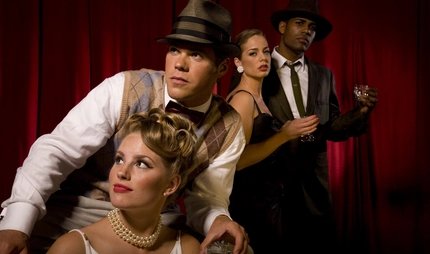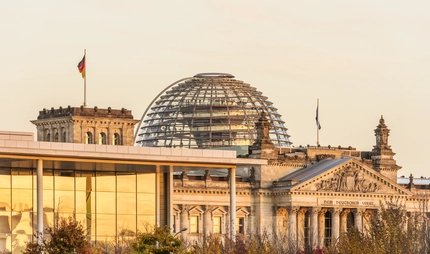
The 1920s – Cultural Life in Berlin
The preface to 1920s culture in Berlin is the First World War. As a consequence of exceptional social disquiet in the city, the National Assembly initially meets in Weimar on the 23rd June 1919. Under intense pressure from the victors, they are forced to sign the Treaty of Versailles, accepting sole responsibility for starting the war. A total of 132 billion marks in penalty payments is levied at Germany, plunging the country into poverty. In the years that follow, social and political unrest aid the far-right movements that lead to World War Two. Yet in the political pressure cooker between the two wars, Berlin's cultural life blossoms to Renaissance-like levels.
A sparkling city
The tragic abyss created by World War I fertilises the cultural life of Berlin. It is as though the city's populace seeks respite from the horrifying realities of the war and its aftermath through artifice and cultural production. New movements crop up in diverse mediums, from theatre, to music, literature and fashion. The permissiveness of the moment also enables queer culture and feminism to make great strides. Around the end of the war, women across Europe gain the right to vote. It is arguably in Berlin that the 'New Woman' is born. She is defined by her short hair and hemline, make-up and joie de vivre. The sass and sophistication associated with the city is aptly represented by an ironic raise of one of Marlene Dietrich's arched eyebrows. There are other female icons too. Josephine Baker's globe-sweeping Charleston dance is introduced to audiences in 1926 in the Nelson Theatre on Kurfürstendamm. "The city had a jewel-like sparkle", Baker said of Berlin. Besides the Charleston, Berlin also welcomes the Shimmy and Two-step to its proliferating dance halls.
Nightlife and new beginnings
As though the city needs to escape the war and its ongoing economic struggles through dream, Berlin's nightlife booms. Cultural life seeks to compensate for political uncertainty with creativity. Berlin becomes synonymous with the glamour, intrigue and bold values associated with the Roaring Twenties. The sharp, raw humour for which Berliners are known finds expression in the era's satirical popular songs. Cabaret performances are full of wit, impudence and lust. Otto Dix captures the zeitgeist in his painting of cabaret dancer and actress Anita Berber, famous for her eccentric behaviour, erotic performances and friendship with intellectuals such as writer Klaus Mann. The city blossoms by day too. In 1921 the world's first Automobile Traffic and Practice Course is constructed in the Grunewald forest to the west of the city. In 1923 Tempelhof Airport is established, and in 1926 the Funkturm (Radio Tower) opens in time for the Third Radio Exhibition. A forward-thinking “Green Week” trade fair is held in 1926 drawing a remarkable 50,000 visitors.
New Objectivity
The city becomes an enclave for creatives of all kinds. Spurning the subjectivity of Impressionism, artists embrace new mediums, such as radio, photography, posters, the press, cabaret and film. The city fosters famous works by Erich Kästner, Joachim Ringelnatz, Billy Wilder, Max Liebermann and many more. British writers like W.H. Auden and Stephen Spender find a bolthole in Berlin, and their writing serves to further reify Berlin's unique allure. Artists meet at the Romanisches Café in Charlottenburg, with their bohemian lifestyle popularising café culture for ever more. Yet this art is by no means anodyne. The aesthetic is bold, shocking and subversive. The emergent style, dubbed New Objectivity, is characterized by a burning desire for truth. Caricaturist George Grosz is fined 300 marks for drawings such as 'Feierabend', which depicts a soldier seeking a sunny bank, only to spot a comrade's corpse floating nearby. Unimpressed with the First International Dada Fair in 1920, Tucholsky writes of Grosz "he alone is Sturm and Drang, riot, ridicule and - as is rarely the case - revolution."
The legacy of 1920s Culture in Berlin
The euphoric atmosphere of the 1920s is offset by bitterness, a formula that comes to define modernity. The economic recovery between 1924 and 1929 feels brittle. New Objectivity increasingly strives to reflect the juxtaposition between the elegant lifestyle of its nouveau riche and Berlin's 133,000 starving unemployed in 1928. Brecht's The Threepenny Opera finds receptive ears when it premieres at Berlin's Schiffbauerdamm the same year. Prescient of the world economic crisis that would reach Berlin in 1929, the Opera provokes bourgeois audiences with the premise that it is "cheap enough for beggars to be able to watch". Even the play's oxymoronic title articulates the contradictions and discomfort of the moment. The world economic crisis leads to the unemployment of some 450,000 people. By 1932, a third of the city is unemployed. The burden of the First World War, the worldwide economic crisis, poverty and a lack of prospects all increase public receptivity to the propaganda of the National Socialist German Workers’ Party. While some artists sympathise with the Nazi party, their election in 1933 drives the majority of Berlin's artists and prominent intellectuals to flee Berlin, going on to spread their influence throughout the world.



